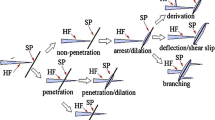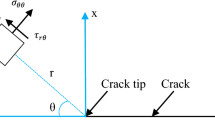Abstract
The key to achieving industrial capacity lies in the fracture network formed by the unconventional reservoir hydraulic volume. In addition, the combination of mechanical and physical properties, reservoir defects and construction parameters of reservoirs has significantly affected the scale of the formed network fractures. Based on the cohesive force model, the secondary development for sub-program is used to realize the diagonal expansion of cohesive elements. Through embedding the global technology in the matrix network, a numerical simulation method for the hydraulic fracturing fracture network of unconventional reservoirs is formed and obtained. Through the comparison between the strain field from the digital speckle experiment and the numerical results, the horizontal strain error rate is 7.08%, which verifies the method to be correct. Based on this, the numerical simulation of network fracture propagation is carried out. The calculation results show that the main controlling factors for the fracture network are elastic modulus, natural fracture toughness and construction injection volume. The larger the elastic modulus of the matrix is, the smaller the fracture toughness of natural fractures are. The larger the construction injection volume, the easier it is to form a fracture network; There are best values for Geostress difference and the natural fracture approximation angle with the Geostress difference of 3 MPa, and the approximation angle of 300–450, which is conducive to the formation of network fractures; The matrix Poisson’s ratio and the viscosity of the fracturing fluid have little effect on the network fracture. Through the global embedding function of the cohesive force elements, study is conducted on the ability of large-scale heterogeneous geological structure to form fracture network and on the influence of various factors on fracture propagation couplingly so as to decide main controlling factors for the formation of fracture network in unconventional reservoirs. This study is of great significance for scientific and rational formulation of the fracturing design process and improvement of the fracturing effect of unconventional reservoirs.
Copyright 2019, IFEDC Organizing Committee.
This paper was prepared for presentation at the 2019 International Field Exploration and Development Conference in Xi’an, China, 16–18 October, 2019.
This paper was selected for presentation by the IFEDC Committee following review of information contained in an abstract submitted by the author(s). Contents of the paper, as presented, have not been reviewed by the IFEDC Technical Team and are subject to correction by the author(s). The material does not necessarily reflect any position of the IFEDC Technical Committee its members. Papers presented at the Conference are subject to publication review by Professional Team of IFEDC Technical Committee. Electronic reproduction, distribution, or storage of any part of this paper for commercial purposes without the written consent of IFEDC Organizing Committee is prohibited. Permission to reproduce in print is restricted to an abstract of not more than 300 words; illustrations may not be copied. The abstract must contain conspicuous acknowledgment of IFEDC. Contact email: paper@ifedc.org.
Access this chapter
Tax calculation will be finalised at checkout
Purchases are for personal use only
Similar content being viewed by others
References
Yin, S., Xie, R., Ding, W., Shan, Y., Shan, W.: Influence of fractal characteristics of conventional and unconventional reservoir rocks on permeability. Lithologic Reserviors 29(04), 81–90 (2017)
Mu, H., Liu, X., Liu, J., Chen, Y., Liu, J., Su, D.: Application of unconventional reservoir volume fracturing technology in the reconstruction of tight sandstone reservoirs. Nat. Gas Explor. Dev. 37(02), 56–60, 63, 11 (2014)
Li, Z., Jia, C., Yang, C., Zeng, Y., Guo, Y., Heng, S., Wang, L., Hou, Z.: Study on hydraulic fracture and stratification surface expansion of shale hydraulic fracturing. Chin. J. Rock Mechan. Eng. 34(01), 12–20 (2015)
Peng, C.: Study on the interference mechanism of hydraulic fracturing cracks and rock mass weak surface of layered shale. Petrol. Drill. Tech. 42(04), 32–36 (2014)
Wang, W., Olson, J.E., Prodanović, M., Schultz, R.A.: Interaction between cemented natural fractures and hydraulic fractures assessed by experiments and numerical simulations. J. Petrol. Sci. Eng. 167, 506–516 (2018)
Zhao, J., Li, Y., Wang, S., Jiang, Y., Zhang, L.: A network simulation of complex fractures under the influence of natural cracks. Nat. Gas. Ind. 34(01), 68–73 (2014)
Xu, D., Hu, R., Gao, W., Xia, J.: Influence of shale stratigraphic structure on hydraulic crack propagation law. Petrol. Explor. Dev. 42(04), 523–528 (2015)
Heng, S., Yang, C., Guo, Y., Wang, C., Wang, L.: Study on the influence of bedding on hydraulic fracture propagation of shale. Chin. J. Rock Mechan. Eng. 34(02), 228–237 (2015)
He, L., et al.: A proppant settling model and its application to the hydraulic fracturing process. Oil Gas Eur. Mag. 40(2), 109–112 (2014)
Daneshy, A.A.: Hydraulic fracture propagation in layered formations. Soc. Petrol. Eng. J. 18(1), 33–41 (1978)
Anderson, G.D.: Effects of friction on hydraulic fracture growth near unbonded interfaces in rocks. Soc. Petrol. Eng. 21(1), 21–29 (1981)
Wang, S., Zhang, Y., Jiang, M., Li, Y.: Study on the mechanism of crack propagation in heterogeneous rock strata. Mech. Eng. 34(06), 38–41 (2012)
Zhao, H., Chen, M.: Extending behavior of hydraulic fracture when reaching formation interface. J. Petrol. Sci. Eng. 74(1), 26–30 (2010)
Youchang, L.: Experimental study on loading rate effect of fracture toughness of layered shale. Chin. J. Rock Mechan. Eng. 37(06), 1359–1370 (2018)
Liu, Y., Li, Z., Zhao, B.: Optimization of the overall fracturing scheme for low permeability reservoirs by orthogonal design method. Fault Block Oil Gas Field 7(03), 46–49, 71 (2000)
Acknowledgement
Heilongjiang Province Science and Technology Plan Provincial Academy of Science and Technology Cooperation Project (YS19A04), Funded by the Postdoctoral Science Foundation of China (2019M661249).
Author information
Authors and Affiliations
Corresponding author
Editor information
Editors and Affiliations
Rights and permissions
Copyright information
© 2020 Springer Nature Singapore Pte Ltd.
About this paper
Cite this paper
Wang, S., Song, W., Li, J., Chen, M. (2020). Numerical Simulation and Main Controlling Factors for Volume Cracks in Unconventional Reservoirs. In: Lin, J. (eds) Proceedings of the International Field Exploration and Development Conference 2019. IFEDC 2019. Springer Series in Geomechanics and Geoengineering. Springer, Singapore. https://doi.org/10.1007/978-981-15-2485-1_78
Download citation
DOI: https://doi.org/10.1007/978-981-15-2485-1_78
Published:
Publisher Name: Springer, Singapore
Print ISBN: 978-981-15-2484-4
Online ISBN: 978-981-15-2485-1
eBook Packages: EngineeringEngineering (R0)




